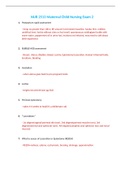NUR 2513 Maternal Child Nursing Exam 2
1.Postpartum rapid assessment - temp no greater than 100.4, BP around 1st trimester baseline, fundus firm, midline, umbilical level, lochia without clots or foul smell, spontaneous voiding(peri bottle with warm water, peppermint oil in urine hat, incisions not infected, may need to talk about birth experience
2.BUBBLE-HEB assessment - Breast, Uterus, Bladder, Bowel, Lochia, Episiotomy/Laceration, Homan's/Hemorrhoids, Emotions, Bonding
3.Involution - when uterus goes back to pre-pregnant state
4.Lochia - bright red at birth (see pg 563)
5.Perineal episiotomy - takes 4-6 weeks to heal(it's a deliberate cut)
6.*Lacerations* - 1st degree(vaginal/perineal skin tear), 2nd degree(perineal muscles torn), 3rd degree(external anal sphincter torn), 4th degree(complete anal sphincter tear and rectal
mucosa)
7.What to assess of Laceration or Episiotomy (REEDA) - REEDA-redness, edema, ecchymosis, bruising, drainage, approximation 8.When does menstruation/ovulation return? - Depends on if lactating. Progesterone pills for birth control only
9.4 stages of Maternal Role Attainment - Anticipatory/pregnancy, Formal/birth, Informal(3-10 months), Personal(3-10 months)
10.3 phases of maternal attachment - Acquaintance, Mutual regulation, reciprocity
11.Postpartum hemorrhage - LARRY(Lacerations, Atony, Retained placenta, Ruptured uterus, You pulled too hard on cord)
12.4 "T's" - tone, trauma, tissue, thrombin
13.Main causes of Postpartum hemorrhage - uterine atony, retained placenta fragments, hematoma, laceration, infection, coagulopathies
14.Risk factors for Postpartum hemorrhage: - high parity, hydramnios, macrosomic fetus, traumatic birth, general anesthetic, oxytocin, chorioamnionitis
15.Signs of postpartum hemorrhage - diaphoretic, change in LOC, dizzy, pale, clammy, hypotension, tachycardia
16.How to fix uterine atony - fundal massage, lower HOB, increase IV fluids, O2, weigh pads, straight cath, anticipate
orders for Pitocin, Cytotec, Methergine(raises BP), Hemabate
17.What should patient know to report? - Severe abdominal pain, increased bleeding
18.Hematoma - pg. 613, signs include unremitting pain and pressure
19.Risk factors for preeclampsia - there's a lot of them basically anything puts you at risk table 11-7 pg 354
20.How to assess for puerperal infection - temp>100.4 on 2 of first 10 days, uterine tenderness, foul-smelling lochia, pain, flu like symptoms
21.Postpartum nursing priorities - monitor for signs of infection/pain/constipation, assess fundus and lochia, assist with breastfeeding, ice to perineum first 24 hours, sitz baths after 24 hours
22.External Cephalic Version(ECV)




